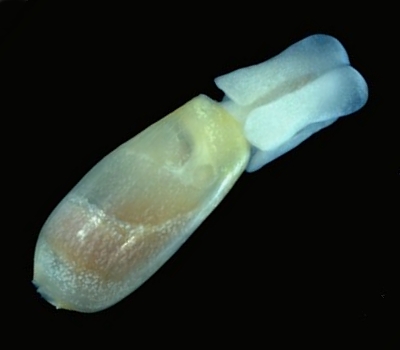
Ascobulla, Cylindrobulla spp.
Order: SACOGLOSSA
Superfamily: OXYNOOIDEA
Family: Volvatellidae
PHOTO
Heron Is, Capricorn Group, Great Barrier Reef, Queensland, Australia, June 1983. In sand at base of Caulerpa. Crawling length of animal & shell 11 mm. Photographer: Bill Rudman
The genus Cylindrobulla was proposed (Fischer, 1857) for small opisthobranchs with a thinly calcified bubble-shaped shell. When live specimens were studied they were found to have a cephalaspid like head shield. Over many years they have been considered primitive opisthobranchs and linked to the cephalaspideans, Akera-like aplysiids, diaphanids and sacoglossans. The anatomy of a number of species has been studied and while many have a sacoglossan-like radula, two west Atlantic species, including the type species, C. beaui Fischer, 1857 have a rather different shaped radular more reminiscent of the diaphanids. This has led to the erection of a new genus Ascobulla Marcus, 1972 for those species with a sacoglossan like tooth. See my separate message [#18254 ] for further discussion.
Both species of Cylindrobulla [with solid triangular denticulate teeth] feed on species of calcified Halimeda, while those with the dagger-shaped sacoglossan teeth [Ascobulla] feed on algae of the genus Caulerpa, which have a relatively soft easily piercible cell wall. They are usually found burrowing in coral sand near algal beds.
Jensen & Wells (1990) suggest the shells of the two genera can be distinguished as follows: "Ascobulla have an almost straight outer lip, a relatively shallow apical area with the protoconch in the centre of a domed inner whorl, and an apical keel continuing in the reflected inner lip. Shells of species .... [of] Cylindrobulla, on the other hand, have a curved outer lip, a deeply sunken apical area with the protoconch completely hidden in the somewhat acentric spire. The apical keel appears to terminate independently on the body whorl."
I can see no way to separate species of Ascobulla and Cylindrobulla from photographs, so unless photographs can be linked to anatomical studies of the actual specimens photographed, I will place them all on this page.
- Clark, K. B. and DeFreese, D. (1987) Population ecology of Caribbean ascoglossa (Mollusca: Opisthobranchia): a study of specialized algal herbivores. American Malacological Union Bulletin 5: 259-280.
- DeFreese, D. E. (1987) Ecology and burrowing behaviour of Ascobulla ulla (Opisthobranchia: Ascoglossa). The Veliger 30: 40-45.
- Fasulo, G., Gaglini, A., and Terreni, G. (1982) Nota su recenti ritrovamenti di un mollusco poco noto, Cylindrobulla fragilis (Jeffreys, 1856) (Gastropoda: Opisthobranchia) e considerazioni sulla sua collacazione sistematica. Notizario CISMA 3: 27-32.
- Hamatani, I. (1971) A new species of Cylindrobulla, sacoglossan opisthobranch, from California: with a comparison with C. japonica Hamatani, 1969. Publications of the Seto Marine Biological Laboratory 19: 111-117.
- Hamatani, I. (1969) A new species of the rare shelled sacoglossan genus Cylindrobulla, from Middle Japan (Opisthobranchiata). Publications of the Seto Marine Biological Laboratory 17: 171-174.
- Ichikawa, M. (1993) Saccoglossa (Opisthobranchia) from the Ryukyu Islands. Publications of the Seto Marine Biological Laboratory 36: 119-139.
- Jensen, K. R. (1983) Factors affecting feeding selectivity in herbivorous ascoglossa (Mollusca: Opisthobranchia). Journal of Experimental Marine Biology and Ecology 66: 135-148.
- Jensen, K. R. (1989) A new species of Cylindrobulla from Phuket, Thailand, with a discussion of the systematic affiliation of the genus. PhuketMarineBiologicalCenter, Research Bulletin 52: 1-11.
- Jensen, K.R. (1996) Phylogenetic systematics and classification of the Sacoglossa (Mollusca, Gastropoda, Opisthobranchia). Philosophical Transactions of the Royal Society of London, B 351, 91-122.
- Jensen, K. R. and Wells, F. E. (1990) Sacoglossa (= Ascoglossa) (Mollusca, Opisthobranchia) from southern Western Australia . In: Wells, F.E., Walker, D.I., Kirkman, H. & Lethbridge, R. Proceedings of the Third International Marine Biological Workshop: The Marine Flora and Fauna of Albany, Western Australia. WesternAustralianMuseum, Perth, Vol. 1: 297-331.
- Lin, G. (1978) A new species of Cylindrobulla (Opisthobranchia) of the Xisha Islands, Guangdong Province, China. Oceanologia et Limnologia Sinica 9: 95-98.
- Marcus, E. and Marcus, E. (1956) On the tectibranch Gastropod Cylindrobulla. Dos Anais da Academia Brasiliera de Ciencas 28: 119-130.
- Marcus, E. and Marcus, E. (1970) Opisthobranchs from Curacao and faunistically related regions. Studies on the Fauna of Curacaoand other CaribbeanIslands 33: 1-129.
- Marcus, E. (1972) On some opisthobranchs from Florida. Bulletin of Marine Science 22: 284-308.
- Melvill, J. C. (1918) Descriptions of thirty-four species of marine mollusca from the Persian Gulf, Gulf of Oman, and Arabian Sea, collected by Mr. F. W. Townsend. Annals and Magazine of Natural History (9), 1: 137-158, 2 pls.
- Mikkelsen, P. M. (1998) Cylindrobulla and Ascobulla in the western Atlantic (Gastropoda, Opisthobranchia, Sacoglossa): Systematic review, description of a new species, and phylogenetic reanalysis. Zoologica Scripta 27: 49-71.
Rudman, W.B., 2006 (November 8) Ascobulla, Cylindrobulla spp. [In] Sea Slug Forum. Australian Museum, Sydney. Available from http://www.seaslugforum.net/factsheet/ascospp
Related messages
-
Re: Ascobulla and Cylindrobulla - are the differences real?
From: Kathe R. Jensen, November 10, 2006 -
Ascobulla and Cylindrobulla - are the differences real?
From: Bill Rudman, November 9, 2006 -
Ascobulla sp from Northern New South Wales
From: Denis Riek, November 9, 2006
